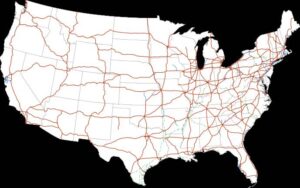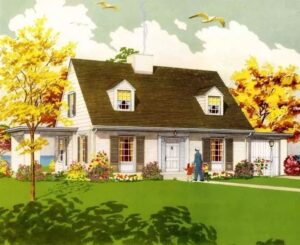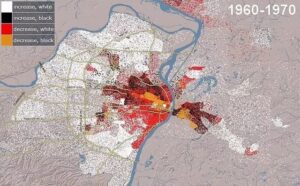(PCC) Program on Chinese Cities – Thoughts on Overseas Travels Series
Authors: xin Chen,
a joint-training PhD student in architectural engineering at Zhejiang University and UNC, specializing in land development and urban internal spatial differences. Email: cx6032500@126.com
Upon first arriving in Chapel Hill, North Carolina, what appeared before me were not skyscrapers of steel and concrete, but rather charming, scattered cottages nestled among green forests and lawns. Even in the busiest and most bustling central areas, there are quaint, stylish, and uniquely-designed small residential houses.
Is this really one of the most modernized countries in the world? Why does it feel more like a large rural village back home? Consider that in China, alongside rapid urbanization, a massive rural population has migrated to cities, while in contrast, America’s middle class continually moves from noisy cities to the peaceful countryside (Image 1). The countryside offers less pollution, better environments, lower housing costs, and lower population densities—all appealing features. However, unlike rural areas in China, rural America doesn’t necessarily mean worse services than the city: typically, a town will have at least one or two cinemas, Walmart and other large supermarkets are standard, and chain restaurants or hotels sporadically dot the landscape, not to mention ubiquitous sports fields, gyms, and swimming pools. As for the houses, they are fully equipped with utilities and internet, roads that lead directly to highways, daily postal services delivering newspapers and mail, and sanitation workers who regularly collect trash and recyclables. It seems quite reasonable then that Americans might prefer to live in the countryside over urban areas.

But why would a country, which achieved high urbanization through generations of effort, revert to being a “Rural Kingdom”? In addition to rapidly advancing economic and technological development, the nature of America’s federal system and social characteristics also contribute to this phenomenon.
-
Technological Developments in Roads, Automobiles, and Energy Provide a Necessary Basis for Rural Living
It’s well known that America is called “A Nation on Wheels,” which depends on three conditions: roads, automobiles, and cheap gasoline. Since President Eisenhower signed the Federal Aid Highway Act in June 1956, a massive interstate highway network has been constructed, now totaling about 70,000 kilometers (2013 data, Wikipedia). These vast concrete webs crisscross and extend from cities to rural areas, significantly easing the flow between urban and rural areas (Image 2). Meanwhile, the proliferation of cars has laid the foundation for people to move from cities to the countryside. Currently, Americans own more than 250 million vehicles, averaging one car per 1.25 people (source: Wikipedia). Urban historian John B. Rae once said that contemporary suburbs are a product of the automobile; without cars, suburbs could not exist. Of course, this is also predicated on the availability of cheap gasoline, with the current average price of gas in the US being $0.67 per liter (source: Global Petrol Prices), compared to the global average of $1.21 per liter. Thus, commuting between cities and rural areas has become neither very time-consuming nor expensive.

-
Strong Promotion by Federal Housing Policies
The 1930s economic crisis in the US dealt a huge blow to the housing market. After Roosevelt came to power, he began to reform federal housing policies. Since then, the Home Owners’ Loan Corporation (HOLC) was established to provide mortgages to low-income families and extend repayment periods; Congress passed the National Housing Act, creating the Federal Housing Administration with more favorable mortgage policies; mortgage interest tax deductions and private residential property taxes began to be reduced shortly thereafter. In addition to the mortgage system, the federal government also introduced a corresponding community loan rating system, which graded communities needing insured loans from A to D, with A being the newest and having the best environment, and D being the most decayed. Since rural areas were usually new and superior, they naturally received priority in government lending, and private lending institutions, to ensure the safety of their funds, followed suit by investing in the countryside rather than reinvesting in urban centers, thus initiating the first wave of rural housing construction.
The second wave occurred after World War II, when over 16 million young American soldiers returned home, eager to marry, have children, and establish their households, creating a sudden surge in housing demand. At the same time, with the ongoing Cold War with the USSR, whether the US could provide sufficient and high-quality housing was not just a domestic policy issue but also a matter of ideological competition. President Truman stated, “How can we expect to spread democracy in Europe if we can’t first prove our system can provide decent housing for our people?” The so-called “decent housing” referred to detached homes with yards, unlike the Soviet-style apartment living (Image 3). However, implementing such housing in the costly urban centers was nearly impossible. Hence, the second wave of suburban construction began under the banner of the “American Dream,” sweeping across the entire US.

-
Racial Disparities Stimulate White Flight
After World War II, a large influx of Black Americans moved to the North and West of the US to fill industrial labor shortages caused by the war. Whites showed great disdain for the newly formed Black communities in cities and began enforcing strict racial segregation to limit Black expansion into White neighborhoods. However, after community segregation was declared illegal in 1948, urbanization among Black Americans spread further, causing panic and anger in White communities. Unable to resist the integration into their neighborhoods, many White families simply abandoned their communities, relocating to suburbs or rural areas. Starting in the 1950s, a phenomenon known as “White Flight” occurred in nearly all major US cities like New York, Chicago, Dallas, Los Angeles, and Philadelphia (Image 4). It was then that Whites enjoyed preferential real estate deals and government subsidies in the suburbs, while Blacks were increasingly clustered in the crowded cities—a direct evidence of modern racial discrimination in the US.

Today’s world indeed shows a variety of characteristics. Just across the ocean, one side embraces a fiery passion to fulfill urban dreams as rural populations surge into cities, while the other side moves to the countryside to enhance their quality of life, redefining the profound implications of urbanization. Living in such a “Rural Kingdom,” one truly feels it is “like a city, not a city; like the countryside, not the countryside.”
References
- Chu Baoyi. Contemporary American Economy. China Financial & Economic Publishing House, 1981.
- Kenneth T Jackson, Crabgrass Frontier: The Suburbanization of the United States. New York: Oxford University Press, 1985: 247.
- Niu Mu’s blog. “Why Has America Returned to Being a ‘Rural Kingdom’?” [EB/OL]. (2012-01-04) [2016-04-10]. http://blog.ifeng.com/article/15720466.html.
- “50 Years of the American Interstate System: A Blessing or a Disaster?” [EB/OL]. (2006-07-07) [2016-04-10]. http://www.360doc.com/content/06/0707/04/7579_150725.shtml.
- “Comparing Rural America to China, Americans Seem to Prefer Living in the Countryside” [EB/OL]. [2016-04-10]. https://kknews.cc/zh-cn/agriculture/6n52yrv.html.
